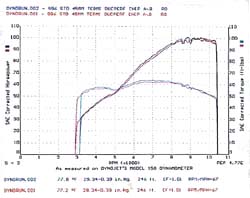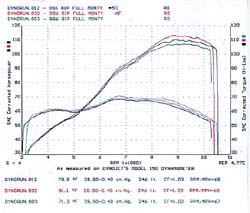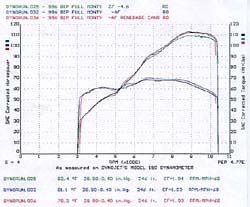|
Following on from our race adventures we were contacted by several 996 owners who were interested as to what a Full Monty preparation job could do for their 996 Biposto's.
The 996 is an impressive beast, the full 98mm bore to increase the capacity from 916 cc to 996 with new design crankcases and cylinder head stud spacing.
These bits had been used on the 916SPS and 996SPS for the previous few years but this is the first time they had trickled down to the Biposto model (for those of you who get it, the Biposto engine is the same as the one supplied in the Monoposto model). To go with the bore job the 996 got bigger inlet and exhaust valves, a higher primary gear ratio and better brake calipers.
 Mark had bought his 996 earlier in 1999 and had been indulging himself in a few add-ons. It seemed obvious that it was not running as he
would wish and he contacted us through email to see if we could help. Before we did anything we ran it on our usual dyno to get a base run. The bike was equipped with 45mm Termignoni look
alikes, a Ducati Performance 'open pipe' chip, carbon airbox and inlet tubes and a big 'over the inlets foam air filter. The attached dyno chart is the 'before we had a play' version. Mark had bought his 996 earlier in 1999 and had been indulging himself in a few add-ons. It seemed obvious that it was not running as he
would wish and he contacted us through email to see if we could help. Before we did anything we ran it on our usual dyno to get a base run. The bike was equipped with 45mm Termignoni look
alikes, a Ducati Performance 'open pipe' chip, carbon airbox and inlet tubes and a big 'over the inlets foam air filter. The attached dyno chart is the 'before we had a play' version.
Our philosophy is to get the best out of the bits we had available and Mark did not want to tune it, he wanted it to be as good as possible on the standard
equipment. At the risk of scaring anyone reading this there are one or two aspects of Ducati motors that need consideration, especially when used on a day to day basis as Mark was doing.
Clutches and belt drive cams are obvious areas of concern to the average owner but having seen a few engines apart I would rate my prime area of concern as the condition of the cam followers.
These rockers are hard chrome plated but are stuck out at the end of a long oil line inside the cylinder heads.
In a typical modern four-cylinder engine, car or bike, the cams press down on a bucket and shim
adjustment system. This system usually has a pool of oil surrounding it, so halfway though its first rotation a cam will get a liberal coating of motor oil. With a Ducati there is no oil pool, the
Desmo system doesn't allow it (except perhaps in the front cylinder head where the exhaust cam sits). The result is that when the motor sits unused the oil in the lines drains away and depending
on the temperature and the vicosity of the oil can take quite a few seconds to get to the rockers and cams; oil delvery remains very restricted until the oil is warm. One solution is to use very thin
oil; to get the stuff to the critical areas as fast as possible, but the reason for the thicker oil is to maintain the oil film on the fairly highly stressed big end shells.
We used a 10w 40 racing synthetic, (no names - you know who you are!) in our Supermono at
Daytona in 1998, it destroyed the big end shells in 250 miles. I freely acknowledge that blitzing round Daytona WFO is hardly 'normal' use but I had hoped for more mileage than that!
Given this trade off the SIGMA prescription is to use a good high film strength (over 17Cst) 10 or
15 w 50 fully synthetic oil, keep it clean and fresh and be very nice to your engine when you start it up. Don't rev it over 2000 rpm or put it under load when cold and try to get the coolant over
the 140 degree mark before you ride off. In very cold conditions (say under 5 degrees C) you can even consider a bit of duct tape on the oil cooler (if you have one).
While the water temp is a good indicator remember it is the oil you are trying to heat up so a bit
of heat in the engine cases would not go amiss. This will take up to five minutes so your neighbours will get a chance to hear the best sound in motorcycling for long enough for you to be
the talk of the neighbourhood! For our own oil choice we decided that it is a lot easier to keep an eye on things, and fix them, in the cylinder heads than deep down in the centre of the engine; we
did not strip the bottom end of our 748 Racer all year in 1999. You have to decide on your own preference.
The reason for this homily is that inside the cylinder heads of Marks 3900 mile old engine there
were 4 terminally damaged opening rockers, the chrome had peeled off where the cam runs on the rocker, you have to take the cams out to spot this sort of damage. It is a good reason to take
the cylinder heads off and do the job properly when checking the valve clearances, if it is not spotted and fixed (only one cure; fit new rockers…about £50 each) it will ultimately destroy the
cam. The damaged rockers were rear cylinder, belt side (furthest from the oil feed, one inlet, one exhaust) openers and both front cylinder inlet openers.
We replaced them all and lapped the valve seats to get a good seal. From what we have seen so
far you need 2000 miles to get a good seal 'as delivered' and everything goes downhill from there as normal wear damages the seat. On the racer we do the valve seats between each race, about
every 350 miles; you would not want to do this for the street. This engine also needed a bit of a decoke, the exhaust ports and piston crowns were starting to resemble a two stroke, it had
definitely been running very rich. We reset the valve clearances to our preferred numbers and measured up the squish. As we expected this was wider than optimum, we measured it all up and
had the barrels machined to close it up to where we wanted it. There is no criticism of Ducati in this, everything is actually built very accurately given the number of engines made; it is just that
we can improve things by taking the time to build an engine individually.
A few other things were found, The alternator was loose (and had been for some time) this is not
good, this is a Denso equipped engine (1999 on) and this is not supposed to happen any more, regrettably this not the first one we have encountered. The new alternator is splined onto the
crankshaft so it stands a chance in these circumstances; on the older style alternators the piece is located by a woodruff key, if the alternator hammers the keyway you will need a new crank to fix
the problem! It is quite easy to dismiss the ominous rumbling at tickover as just the clutch; as it slowly gets louder it kinda creeps up on owners, something to get checked and loctited every
service. The clutch was also damaged with the friction plate tangs peened over on their load bearing edge, the basket was also badly ridged. The clutch was not slipping and actually worked
quite well, all things considered, but it was as noisy as hell and I would not bet on it continuing to work for long.
On the rebuild we also checked the valve timing, the exhaust cams were as close as you can
adjust using offset keys, remember they did not start there 'cos we changed the squish, that will have the effect of rolling the cam if all other things are equal. The inlets were both out a bit
requiring a 4 degree key in the vertical cylinder and a two degree in the front, a significant, power sapping, 6 degree difference between the inlet closing points on the two cylinders.
On reassembly we found the Throttle Position Sensor was 22 milli-volts out when fully closed and
the balance between the two cylinders was also out a little. All these things add up, either the engine is running smooth and making serious, smooth, power, or each cylinder is fighting the
other, that very quickly loses power and makes things rough, especially in the mid range under acceleration. Once everything was set up, fresh oil and filter, adjusted chain, nice new FIM Eprom, the lot we were off to the dyno, and a very interesting trip it was.
 The attached charts show the story. Dynorun 003 shows the engine straight after we had finished
working on it. The CO2 was obviously rich so we moved the 'Zones' within the Eprom to ensure we got the area above 6600 rpm and then leaned it out in stages, Dyno run 012 was the result. To see
if we could find the reason for the over rich mixture we took off the tank, removed the big non standard foam filter and ran it again, Dynorun 032 shows the outcome; 113 bhp, up 13 bhp from the bike 'as
delivered'. The noise from under the tank was very different without the foam stuffing. I am pretty sure half the problem is that the foam damps down the airbox pulsing, alternatively the
foam trapped between the tank front and the air intake acts pretty much like sticking a rag in the inlet port … The attached charts show the story. Dynorun 003 shows the engine straight after we had finished
working on it. The CO2 was obviously rich so we moved the 'Zones' within the Eprom to ensure we got the area above 6600 rpm and then leaned it out in stages, Dyno run 012 was the result. To see
if we could find the reason for the over rich mixture we took off the tank, removed the big non standard foam filter and ran it again, Dynorun 032 shows the outcome; 113 bhp, up 13 bhp from the bike 'as
delivered'. The noise from under the tank was very different without the foam stuffing. I am pretty sure half the problem is that the foam damps down the airbox pulsing, alternatively the
foam trapped between the tank front and the air intake acts pretty much like sticking a rag in the inlet port …
 We had some different pipes to try, Mark had had some hybrid 50mm pipes made for the bike by Renegade, these were 50 mm diameter from the
end of the crossover, (a 'proper' 50mm intermediate system goes to 50mm in the crossover manifold. The effect of this slight reduction in back pressure was inconclusive, less
power at 5,000rpm, a very little more at 5,000rpm and then less all the way to 10,000 rpm, when we say less or more it is never more than a single horsepower. On the basis that we are after nice
smooth easy power we decide the best bet were the standard 45mm pipes but the 45/50 pipes would be almost as good in most circumstances, and being Renegades are stainless and easily
rebuildable. The third chart shows the difference; 025 is the best we could get with the big foam undertank air filter, 032 and 036 show the difference between the pipes, both without the foam filter. We had some different pipes to try, Mark had had some hybrid 50mm pipes made for the bike by Renegade, these were 50 mm diameter from the
end of the crossover, (a 'proper' 50mm intermediate system goes to 50mm in the crossover manifold. The effect of this slight reduction in back pressure was inconclusive, less
power at 5,000rpm, a very little more at 5,000rpm and then less all the way to 10,000 rpm, when we say less or more it is never more than a single horsepower. On the basis that we are after nice
smooth easy power we decide the best bet were the standard 45mm pipes but the 45/50 pipes would be almost as good in most circumstances, and being Renegades are stainless and easily
rebuildable. The third chart shows the difference; 025 is the best we could get with the big foam undertank air filter, 032 and 036 show the difference between the pipes, both without the foam filter.
We did an all gear run and ran it up through sixth to the redline; this thing is geared for 188 mph
in top, it is simply never going to get there in the real world. That makes sixth a very high overdrive, I can only believe it is done to allow the bike through the drive by noise test. Standard
is a 15 tooth front sprocket so a 14t sprocket drops the redline top figure to around 175 mph and keeps the top speed at nearly 170mph, you just get there a hell of a lot quicker… The 748's with
the same basic chassis come standard with a 14t front so safety should not be an issue as long as one remembers that things will happen a lot quicker when one twists the throttle.
 Finally just to really bring home how strong this
engine is we present a chart comparing a 996SPS (003-996 base run post TT) we ran on the dyno on the same day with Marks motor (032). To be fair the SPS has had the valve timing and squish set by
us but has completed a full TT and a couple of other races since we built it. See separate article on the refresher and a few other bits we tried on the SPS, nevertheless I think the Bip holds its head
up very well don't you? Finally just to really bring home how strong this
engine is we present a chart comparing a 996SPS (003-996 base run post TT) we ran on the dyno on the same day with Marks motor (032). To be fair the SPS has had the valve timing and squish set by
us but has completed a full TT and a couple of other races since we built it. See separate article on the refresher and a few other bits we tried on the SPS, nevertheless I think the Bip holds its head
up very well don't you?
Neil Spalding
|